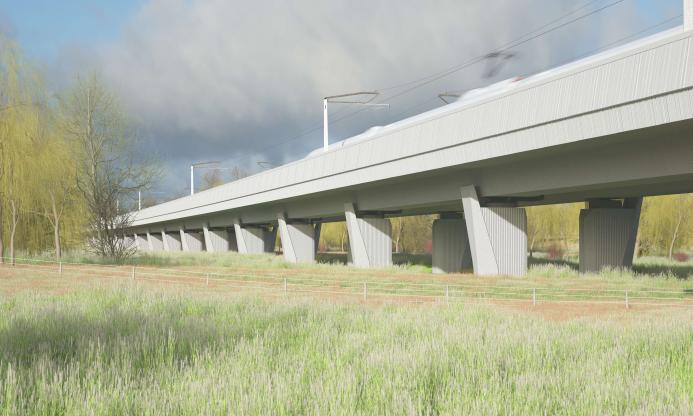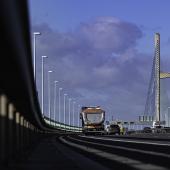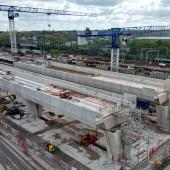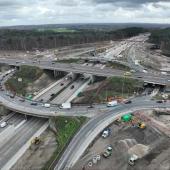Structural redesign cuts carbon in HS2’s Edgcote viaduct
Viaduct is second to have every major element manufactured off-site, saving carbon and simplifying construction
HS2 have revealed new images showing its Edgcote Viaduct, which, after a structural redesign, has had its carbon footprint cut by more than 13% in comparison to the previous design.
Set low into the landscape of west Northamptonshire, the 515m-long viaduct will carry the railway across the floodplain of the River Cherwell, south of Chipping Warden.
It is one of more than 50 major viaducts being built as part of the HS2 project, which is designed to free up space on the most crowded part of the existing West Coast mainline and drive growth across the UK.
To achieve the impressive carbon saving, engineers adopted the same pioneering approach developed for the Thame Valley Viaduct, near Aylesbury. This lighter-weight, modular design cuts the amount of concrete and steel in the design and will be manufactured off-site at a facility in Kent.
Instead of five beams per span, secured with concrete poured in situ, the team will use just two larger ‘u’ shaped beams per span, secured directly to the next pair of beams. While not significantly changing the height or length of the viaduct, this structural change will reduce the number of lorry movements and speed up construction.
At between six and eight meters high, the viaduct will be supported by 20 pairs of pre-cast concrete piers. From a distance, it will be largely hidden by existing hedgerows and woodland.
Paul Cooper, HS2’s senior project manager, said: “The success of the Thame Valley Viaduct design shows that a two-beam approach can deliver dramatic carbon savings and speed up construction – particularly for longer viaducts – so it’s great that we’ve been able to roll it out again at Edgcote.”
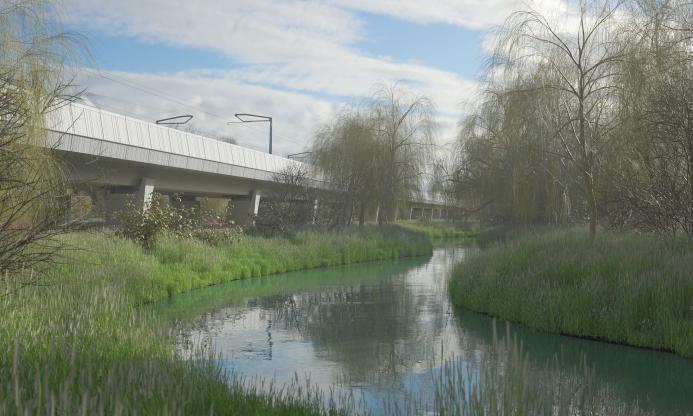
As well as changes to the beams, the piers will also be narrower and extended to almost connect with the parapet edge, helping to enhance the appearance of a light and narrow structure.
Edgcote is one of 15 viaducts designed by HS2’s main works contractor, EKFB - a team made up of Eiffage, Kier, Ferrovial Construction, and BAM Nuttall - working with their design partner, ASC (a joint venture between Arcadis Setec and COWI) and specialist architects Moxon.
Both Thame Valley and Edgcote owe a lot of their inspiration from recent high-speed rail projects in Spain, the design team cut the amount of embedded carbon by simplifying the structure of the viaduct so that every major element – the piers, beams, deck planks, and parapet - can be made off-site.
The build contract for both viaducts has been awarded to FC Civils Solutions, to act as EKFB’s specialist on-site construction partner.
The production of steel and concrete is a major contributor to carbon emissions, with the new lighter-weight structure expected to save 360 tonnes of embodied carbon in comparison to the previous design. That’s the same amount of carbon emitted by one person taking a flight from London to Edinburgh and back 1,865 times.
As well as cutting embedded carbon in terms of materials, this approach requires fewer lorries to deliver material to the site, cuts waste, and improves safety by reducing the amount of working at height – and is particularly suited to longer viaducts like Edgcote and Thame Valley.
The last few weeks have also seen significant progress at HS2’s other major viaducts, with the first concrete poured for the approach viaducts for Birmingham Curzon Street station, the first beams installed at Thame Valley near Aylesbury, and the completion of beam installation at Highfurlong Brook in Northamptonshire.
In total, HS2 is building more than 500 bridging structures – ranging from small road bridges to massive viaducts like the record-breaking Colne Valley Viaduct which will become the longest in the UK and recently passed the halfway point.

